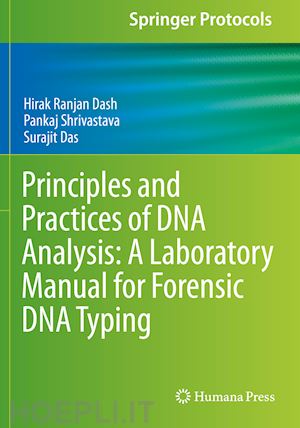
Questo prodotto usufruisce delle SPEDIZIONI GRATIS
selezionando l'opzione Corriere Veloce in fase di ordine.
Pagabile anche con Carta della cultura giovani e del merito, 18App Bonus Cultura e Carta del Docente
The book presents hands-on protocols for conventional and advanced forensic DNA fingerprinting experiments. It includes manual, semi-automatic, and advanced automatic techniques for DNA extraction from different biological samples.
It also discusses various qualitative and quantitative approaches for the assessment of extracted forensic DNA. It contains protocols for the amplification of short tandem repeat markers (STRs) for the amplification-based target enrichment of the forensic samples.
Further, it examines genotyping of the STR loci through capillary electrophoresis and includes real-world case studies where forensic DNA analysis has been used in the criminal and civil disputes. The book concludes by presenting technological developments in the field of DNA forensic analysis.
Suitable for beginners, it is a key reference resource on a wide variety of DNA profiling techniques and applications.
Dr. Hirak Ranjan Dash is currently a Scientific Officer at the DNA Fingerprinting Unit, Forensic Science Laboratory, in Sagar, Madhya Pradesh, India. He completed his Ph.D. at the National Institute of Technology, Rourkela, India in 2015, and has since been working in the area of microbial ecology, forensic microbiology, and human genetics. In addition, he is a member of various scientific societies, including the International Society for Forensic Genetics, Association of Microbiologists of India and Students Association of Microbiology. He has been engaged in forensic DNA fingerprinting examinations in criminal and civil cases including the cases related to paternity, child swapping, rape, identity and incest. He has authored more than twenty five papers in reputed peer-reviewed international journals and has published four books.
Dr. Pankaj Shrivastava has broad interests in several areas of forensic DNA fingerprinting including population-based DNA analysis, developing protocols in forensic DNA typing, validating new multiplex kits and optimizing different steps in forensic DNA typing methodology. He has supervised Ph.D. students and published over 40 research papers in peer-reviewed international journals. His publications in Forensic Science International Genetics, Nature Scientific Reports, Legal Medicine, International Journal of Legal Medicine, Annals in human Biology etc., have earned him wide acclaim from the forensic DNA community. He is presently working at the DNA Fingerprinting Unit in State Forensic Science Laboratory, Govt. of Madhya Pradesh, India. He is a member of International Society for Forensic Genetics (ISFG), Indian Society of Human Genetics (ISHG), Association of Microbiologists of India(AMI) and Association for the promotion of DNA Fingerprinting and other DNATechnologies (ADNAT).
Dr. Surajit Das is an Associate Professor at the Department of Life Science at the National Institute of Technology, Rourkela, India. His field of research includes microbial genomics, biosynthesized nanoscale materials, marine biotechnology, environmental microbiology and bioremediation. He is serving as the Editor of Plos One and BMC Microbiology journal. He has published more than 70 research papers in peer-reviewed national and international journals and authored 7 books.











Il sito utilizza cookie ed altri strumenti di tracciamento che raccolgono informazioni dal dispositivo dell’utente. Oltre ai cookie tecnici ed analitici aggregati, strettamente necessari per il funzionamento di questo sito web, previo consenso dell’utente possono essere installati cookie di profilazione e marketing e cookie dei social media. Cliccando su “Accetto tutti i cookie” saranno attivate tutte le categorie di cookie. Per accettare solo deterninate categorie di cookie, cliccare invece su “Impostazioni cookie”. Chiudendo il banner o continuando a navigare saranno installati solo cookie tecnici. Per maggiori dettagli, consultare la Cookie Policy.